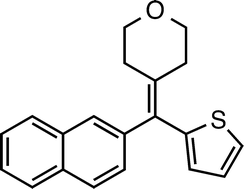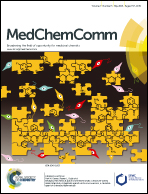Non-substrate based, small molecule inhibitors of the human isoprenylcysteine carboxyl methyltransferase†‡
Abstract
Activating mutations of human K-Ras proteins are among the most common oncogenic mutations, present in approximately 30% of all human cancers. Posttranslational modifications to K-Ras guide it to the plasma membrane and disruption of this localization inhibits the growth of Ras-driven cancers. The human isoprenylcysteine carboxyl methyltransferase (hIcmt) enzyme catalyzes the final α-carboxyl methylesterification of the C-terminal farnesyl cysteine of K-Ras, which is necessary for its proper localization. Thus, hIcmt inhibition is a regarded as a promising cancer therapy. A high quality inhibitor of hIcmt with in vivo activity would advance hIcmt research and drug development. Herein, Wwe report the results of a screen for small molecule hIcmt inhibitors in a library of molecules that were not hIcmt substrate analogs. The lead compound identified by this screen (1) was modified to remove chemical liabilities and to increase potency. The most potent resulting compound (5) inhibited hIcmt in vitro with low micromolar potency (IC50 = 1.5 ± 0.2 μM) and was kinetically characterized as a competitive inhibitor for prenylated substrates and a non-competitive inhibitor for the cofactor and methyl donor S-adenosylmethionine (SAM). These inhibitors offer important structure activity relationships for the future development of hIcmt inhibitors with in vivo activity.


 Please wait while we load your content...
Please wait while we load your content...